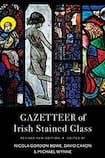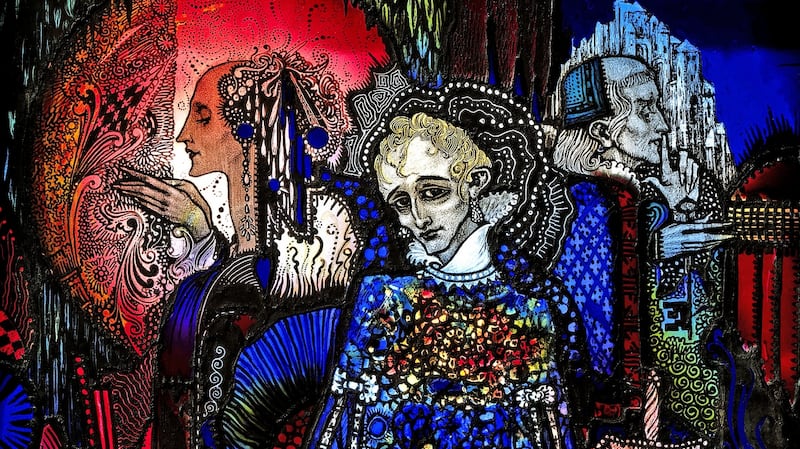
Some years ago in Miami, a sudden rainstorm accompanied by an argument caused me to look for shelter in a museum. That’s how I met Harry Clarke’s astonishing The Geneva Window.
The story of how this masterpiece came to be in the Wolfsonian Museum, rather than at the League of Nations building in Geneva, for which it had originally been commissioned, has been extensively covered elsewhere. Suffice to say, the window, which celebrates Irish writers, was considered scandalous by 1930s politicians, although what is perhaps even more scandalous is that it wasn’t lost to Ireland until as recently as the 1980s.
The Geneva Window is pictured in the latest edition of the Gazetteer of Irish Stained Glass, alongside other examples of Clarke’s wonderful work including his Eve of St Agnes, on view in Dublin’s Hugh Lane Gallery. The world over, stained glass shows how the right combination of light, line and colour can take your breath away, and Irish artists have been particularly good at it.
The original edition of the Gazetteer, by Nicola Gordon Bowe, Michael Wynne and David Caron was published in 1988. Gordon Bowe, who championed scholarship in, and passion for stained glass died in 2018 and Wynne, keeper and research curator at the National Gallery of Ireland, in 2003. And so it is Caron who has overseen the updated edition, adding an essay exploring the art from the mid-20th century to the present, and a trove of glowing photographs, most of them by Jozef Vrtiel.
As its name suggests, the main part of the Gazetteer is devoted to a county-by-
county listing of where to find Irish stained glass. Essentially it is an extended index, which makes it a handy travel companion if your own staycations involve church-spotting and a more general seeking out of artistic and architectural significant sites. However, the fact that most of us travel with a smartphone these days does make me hungry for an online version to search by artist as well as location.
Online indexes do exist: gloine.ie, a database of windows in Church of Ireland churches, is useful if glitchy; Lucy Costigan and Michael Cullen's harryclarke.net is a trove of information on the location of Clarke's works, among them the Honan Chapel at UCC, a building just emerging from major restoration.

As the Gazetteer shows, Clarke is not the only stained glass artist in town, and with more than 2,500 entries, you can see how Irish artists really shone. With a couple of exceptions, the publication limits itself to Irish artists, and also excludes works where direct attribution can’t be confirmed. As such, it’s an invaluable reference book for scholars, whereas excited enthusiasts such as myself are left a little hungry for more.
For example, the introductory essays gallop through various techniques, and I would have loved a glossary section to refresh my memory on the differences between etching, enamelling, dalle de verre, painting and pot glass. Similarly the essays only have space to hint at how central stained glass was to the emerging post-independence Irish identity, and to offer glinting glimpses of fascinating histories.
We have Edward Martyn, dramatist, politician and the first Sinn Féin president, announcing that “if we are determined to have bad work, it is better to have it bad Irish than bad foreign”. He and the influence of the Arts and Crafts movement led to the founding of An Túr Gloineg by Sarah Purser, initially to create glass for the new cathedral at Loughrea.
Purser was hugely supportive of stained glass artists, including Wilhelmina Geddes, though not it seems Evie Hone, who was told to go to art school. Ultimately Hone was advised by a curator at the Victoria and Albert Museum to approach Geddes herself, who would help the younger artist to discover the tools of the trade. An illustration of Hone’s Apparition of Fatima at the Catholic Church at Kingscourt, Co Cavan shows the artist’s genius.
While the Arts and Crafts movement saw stained glass increasingly used in a domestic setting, the majority of works in the Gazetteer are religious. For me the overriding sense is spiritual. It is easy to imagine, in a pre-mass literacy era, the narratives of stained glass leading congregations to the mysteries of God, although those literal interpretations are perhaps less necessary today.
In 2009, the year before he died, German artist Sigmar Polke finished a series of windows for Zurich’s Grossmünster. Made from incredibly thin slices of agate, in just the right light, they would cause you to believe in a higher power, a benevolent creator gifting the potential of such glories to the world.
In Caron’s essay, a quote by Cork-based contemporary stained glass artist James Scanlon sums it up: “Glass, for me, is for the things that tear the heart out of me – I would put them into the glass. And they would mean a lot to me. When you look at it, it brings a calmness over you. When it’s finished and the calmness comes out of it over me, then it’s finished.”












